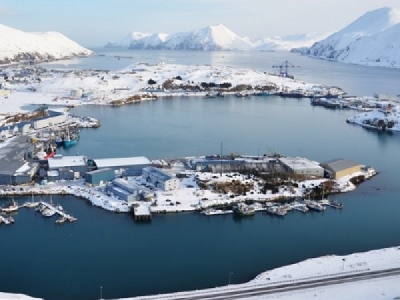
Posted on October 22, 2018
Bigger ships won’t be coming, but the big ones that call regularly will be able to get in and out easier if the U.S. Army Corps of Engineers blasts and scoops 16 feet from the bottom near the Dutch Harbor Spit in a proposed $29 million project at least four years away.
“Our proposed project won’t accommodate anything deeper than what’s already coming to Dutch Harbor,” but it will allow safer and more efficient movements of the giant container ships, said Ronnie Barcak, the U.S. Army Corps of Engineers’ “Unalaska (Dutch Harbor) Channel Navigation Improvements” project manager.
The Corps came to Unalaska to update city officials, and the public, on dredging plans, two years since their last visit on the project sought by the Unalaska City Council.
The extra depth, if the U.S. Congress comes up with funding matched by the city, will allow the ships to move with more maneuverability.
The project will require blasting prior to excavation, and hopefully no explosive surprises from legacy military weapons in its ultimate quest to deepen the water level from 42 to 58 feet at the average depth known to mariners as mean lower low water.
The Corps wants to see if 14 unidentified metallic objects are bombs, by taking a closer look with an underwater remotely operated vehicle, before dredging the 600 by 600-foot underwater area, to deepen shallow water caused by a shoal from a moraine deposited by an ancient glacier just offshore of the Dutch Harbor Spit.
The one-year project would be completed, at the earliest, in 2022.
Unexploded munitions have been found in the area, left behind by the U.S. military during the Aleutian Campaign in World War II, and the Corps displayed photos of rusted landmines and projectile bombs previously encountered in local waters.
The shoal, commonly called a bar, is very hard and will first require loosening up with explosives, which will require an “incidental harassment permit” because of the likely presence of marine mammals including sea lions, sea otters, seals, and humpback whales.
There are so many marine mammals in the area that it would be impossible to blast the hard-packed underwater ridge without potentially impacting them, said George Kalli of the U.S. Army Corps of Engineers, saying the project couldn’t go forward without the federal environmental permits for disturbing marine mammals for the sake of maritime progress. The project is expected to require only a federal environmental assessment, and not a more detailed and time-consuming environmental impact statement, he said.
The present cost estimate of $29 million is expected to change, Kalli said, though he couldn’t predict if the price would go up or down.
Local resident Suzi Golodoff was concerned that the dredging of 16 feet of sea floor, from the present depth of 42 feet down to 58 feet, could cause erosion on the Front Beach along Bayview Ave., where hers and other homes are located in the historic downtown area of Unalaska.
Corps officials said that was unlikely, that the project would have minimal impact on the Front Beach.
The route for the deeper channel for the big container ships and tankers was studied with a vessel movement simulator at the Corp’s research facility in Vicksburg, Miss., using a simulation of a container ship that stops in town regularly while sailing from the U.S. West Coast to Asia with seafood cargo, the APL Holland, as the “design vessel,” with the input from local marine pilot Bill Gillespie, of Alaska Marine Pilots.
The project would involve the removal of 182,000 cubic yards of material from the seafloor, and local resident Travis Swangel saw an opportunity to recycle the material for new landfill docks in Captains Bay, but Kalli said that would cost the government extra for the cost of barging the material, and suggested he’d get a better deal from a local quarry business, Bering Shai Rock and Gravel.
Corps officials are planning to dump the material elsewhere in the area, in deep water, spread out evenly on the bottom, although Vice Mayor Dennis Robinson said an underwater mound could create attractive new habitat where fish would congregate.
The Corps held three community events during their recent visit attended by six of the federal employees from Anchorage, first an open house at the Burma Road Chapel where local residents reviewed various documents explaining economic and environmental impacts spread out on tables, and then two meetings at Unalaska City Hall, one in the evening for the community, and the next day at a noon session of the city council earlier this month.
Source: The Bristol Bay Times





